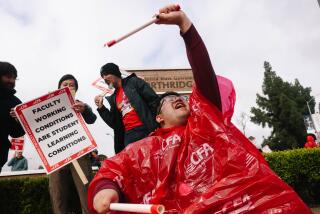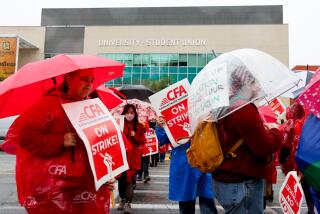CSUN, Soviet University Forge Academic <i> Glasnost</i>
- Share via
With jokes and a hug, the president of a Soviet university Friday signed an agreement with his counterpart at Cal State Northridge to collaborate on research and swap professors, graduate students and books.
The agreement ended a weeklong visit to CSUN by Vladymyr Prisnyakov, rector (the equivalent of president) of Dniepropetrovsk State University in the Ukraine.
“If each of us has one apple, each of us now has two apples, not one--and the same thing with an exchange of ideas . . . everybody will have two ideas,” Prisnyakov said. His Russian was interpreted by Dniepropetrovsk history professor Sergei Plokhy.
Prisnyakov and CSUN President James Cleary, wearing pins of the U.S. and Soviet flags on their lapels, hugged each other during the signing ceremony in Cleary’s office. They bantered about ballet and about a gift bottle of Ukrainian horieka, a vodka with hot peppers from a 16th-Century Ukrainian Cossack recipe.
Academic Swapping
The presidents began the academic swapping. Cleary presented a volume of Robert’s Rules of Order, which he co-edited, and Prisnyakov and Plokhy gave Cleary books they wrote on space propulsion, science and Ukrainian church history.
Cleary said CSUN hopes to draw on Dniepropetrovsk’s expertise in science and math. He said he would try to visit the Ukraine early next year.
The Dniepropetrovsk scholars were impressed with CSUN’s teaching of its 750 disabled students. “We want to learn the methodology, how to prepare teachers to work with the handicapped,” Prisnyakov said.
Disabled students at CSUN are helped by note-takers and sign-language interpreters. They do their homework on specially equipped computers.
Although CSUN has similar agreements with several universities in China and Brazil, this is a first for the 12,000-student Dniepropetrovsk State. Before glasnost and perestroika, Prisnyakov said, his university was closed to foreigners because it does space research.
It is now negotiating exchanges with schools in East Germany, West Germany, Bulgaria, Poland and Denmark.
The idea for the CSUN exchange started after Plokhy, while a visiting professor at Harvard University in 1987, came to give a lecture at CSUN.
This past week, Prisnyakov, Plokhy and political science professor Anatoly Savyalov lectured on political reforms in their country, Soviet policy in the Third World and mathematical modeling of the human brain. They also sat in on classes and a faculty meeting and toured the library and computer center.
Soviets and Americans seem to share a sense of humor, the visitors said, but education operates differently in the two countries. Americans seem to get more practical instruction, whereas Soviet students get heavy doses of theory, Prisnyakov said. American students spend much time studying on their own in the library or lab, while Soviets spend more time in the lecture hall, he said.
He also said that CSUN students appear to have a more informal relationship with their professors than Soviet students do.
Savyalov said CSUN students grilled him on perestroika and U.S.-Soviet relations. He said he was impressed by the quality of some of the questions. “It shows students are informed about events in the Soviet Union,” he said, saying that some of the questions “were even difficult to answer in Russian,” much less in English.
The Soviet educators will return to the Soviet Union today after a trip to Disneyland.
At CSUN they stayed in university housing and ate dorm food, which they found “not bad.” They saw the Joffrey Ballet, Hollywood and Mann’s Chinese Theater.
“But we didn’t leave our own handprints,” Savyalov joked.
“But we’ll leave more than our handprints,” Prisnyakov said. The cooperation with CSUN “will be the best print.”
More to Read
Sign up for Essential California
The most important California stories and recommendations in your inbox every morning.
You may occasionally receive promotional content from the Los Angeles Times.













